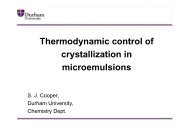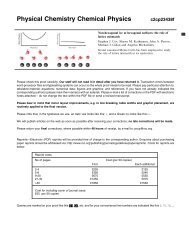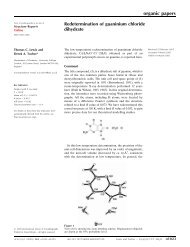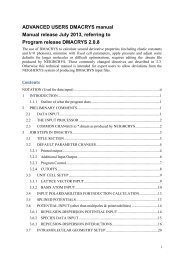An Introduction to the Theory of Crystalline Elemental Solids and ...
An Introduction to the Theory of Crystalline Elemental Solids and ...
An Introduction to the Theory of Crystalline Elemental Solids and ...
Create successful ePaper yourself
Turn your PDF publications into a flip-book with our unique Google optimized e-Paper software.
20<br />
TABLE 2: Bulk properties <strong>of</strong> C, Si, <strong>and</strong> Ge, as computed with <strong>the</strong> LDA, PBE, TPSS, <strong>and</strong><br />
PBE0 exchange-correlation functionals. All data is taken from Refs. [63] <strong>and</strong> [56]. Ref. [63] is<br />
an all-electron study with a Gaussian basis set. Data from ref. [56] has been obtained with <strong>the</strong><br />
plane-wave plus PAW method. Note that <strong>the</strong> PBE0 functional has not yet been employed <strong>to</strong><br />
treat Ge.<br />
a 0 (Å) B 0 (Mbar) E coh (eV)<br />
Ref. [63] Ref. [56] Ref. [63] Ref. [56] Ref. [63] Ref. [56]<br />
C LDA 3.54 4.54 8.83<br />
PBE 3.58 3.57 4.22 4.31 7.62 7.71<br />
TPSS 3.58 4.17 7.12<br />
PBE0 3.55 4.67 7.59<br />
expt. 3.57 4.43 7.37<br />
Si LDA 5.43 0.95 5.26<br />
PBE 5.49 5.47 0.89 0.88 4.50 4.56<br />
TPSS 5.48 0.92 4.36<br />
PBE0 5.43 0.99 4.56<br />
expt. 5.43 0.99 4.62<br />
Ge LDA 5.63 0.76 4.72<br />
PBE 5.77 0.63 3.82<br />
TPSS 5.73 0.66 3.78<br />
PBE0<br />
expt. 5.65 0.76 3.87<br />
with <strong>the</strong> PBE0 functional) PBE0 does, indeed, <strong>of</strong>fer slightly improved performance<br />
compared <strong>to</strong> <strong>the</strong> o<strong>the</strong>r functionals. PBE0 gets <strong>the</strong> lattice constants <strong>of</strong> both materials<br />
correct <strong>to</strong> within 1 %, <strong>the</strong> bulk moduli <strong>to</strong> within 5 % <strong>and</strong> <strong>the</strong> cohesive energies <strong>to</strong> within<br />
3 % <strong>of</strong> <strong>the</strong> corresponding experimental values.<br />
In conclusion, we again see that all functionals discussed perform reasonably well in<br />
capturing <strong>the</strong> variation in lattice constants <strong>and</strong> bulk moduli for <strong>the</strong> small collection <strong>of</strong><br />
covalently bonded solids considered. As we observed for metals, <strong>the</strong> situation with regard<br />
<strong>to</strong> <strong>the</strong> quantitative determination <strong>of</strong> E coh is far from satisfac<strong>to</strong>ry with <strong>the</strong> choice <strong>of</strong><br />
exchange-correlation functional crucial <strong>to</strong> <strong>the</strong> value obtained. Finally, before closing this<br />
section we briefly discuss one fur<strong>the</strong>r important aspect <strong>of</strong> DFT calculations <strong>of</strong> covalent<br />
elemental solids, namely how <strong>the</strong> computed b<strong>and</strong> gaps compare <strong>to</strong> <strong>the</strong> experimental ones.<br />
We have indicated already that <strong>the</strong> computed Kohn-Sham b<strong>and</strong> gap depends sensitively<br />
on <strong>the</strong> exchange-correlation functional used <strong>and</strong> generally it is found that <strong>the</strong> LDA<br />
<strong>and</strong> GGA functionals predict Kohn-Sham b<strong>and</strong> gaps that are considerably smaller than<br />
<strong>the</strong> experimentally observed optical b<strong>and</strong> gaps. The LDA <strong>and</strong> PBE b<strong>and</strong> gaps <strong>of</strong> C in<br />
<strong>the</strong> diamond lattice, for example, are ∼4.2 <strong>and</strong> ∼4.8 eV, respectively, compared <strong>to</strong> <strong>the</strong><br />
corresponding experimental value <strong>of</strong> ∼7.3 eV [56, 64]. Moving <strong>to</strong> <strong>the</strong> hybrid functionals<br />
such as PBE0 leads <strong>to</strong> increased b<strong>and</strong> gaps through <strong>the</strong> inclusion <strong>of</strong> a fraction <strong>of</strong> Hartree-<br />
Fock exchange <strong>and</strong> generally (but not always) this improves <strong>the</strong> b<strong>and</strong> gap compared<br />
<strong>to</strong> <strong>the</strong> pure DFT functionals. The PBE0 b<strong>and</strong> gap for C, for example, is at ∼6.7 eV







